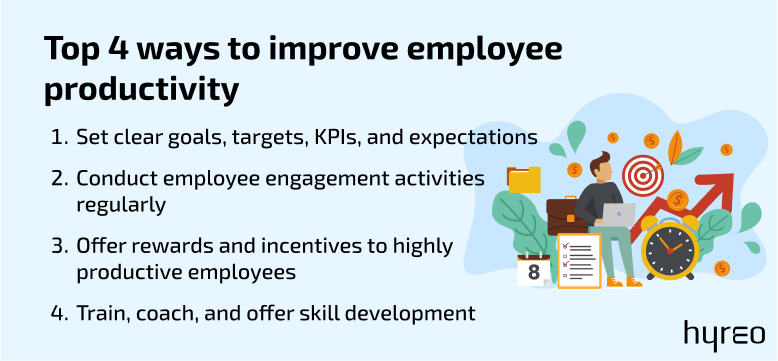One of the familiar and extremely satisfying feelings for most people is when they get work done. They feel productive. When it comes to businesses, “getting work done in a specific time” is generally defined as productivity. It is also a fact that workforce productivity is necessary since it is related to the sustenance, development, customer service, and profit of any organization.
However, there is more to employee productivity than meets the eye. Though organizations and businesses have their idea of workforce productivity, it is imperative to understand this concept as a whole and how to improve it.
What is employee productivity?
The concept of employee productivity is age-old. From the building of the pyramids to modern-day developments, managers have always banked on maximum productivity to achieve the set goals.
For leaders in an organization, the productivity level of employees is a direct indicator of how successful the organization will be over time.
By definition, workforce productivity is the number of goods and services that a group of workers produces in a given amount of time.
Another definition states that productivity is the output of an employee in a specific period.
This sounds more apt since being busy and being productive are two very different things. An employee can seem to be doing a lot of work but unless it meets a desired outcome or goal, all the effort seems meaningless.
Why is it important to track employee productivity?
Though employees tend to claim to be productive, it becomes important to track their levels of productivity. After all, employee productivity has a direct bearing on the following aspects of an organization:
- Consistent productivity contributes to the top and bottom lines of any organization. The company’s investment in an employee pays off when an employee’s performance is optimal. Optimum performance helps in meeting business and financial goals, ensuring a definite profit.
- With the deliverables at their best and on time, productivity helps build strong customer relationships and guarantees customer loyalty.
- Customer goodwill leads to a reliable brand image, again an unquestionable sign of success.
- It also adds to the effectiveness (right steps towards a goal/quantity) and efficiency (right way of executing the right steps/quality) of the workforce.
How to quantify employee productivity?
Before looking at the formula to quantify employee productivity, there are a few things you should know:
Myth 1: Productivity is exponential.
Productivity is more of a spiral. There are days when employees are at their best and days when they slack. But as long as deadlines and set performance quality standards are met, the employee can be considered to be productive.
Myth 2: The more time spent at work, the higher the productivity.
Being busy and being productive are quite different. One can seem to be doing a lot of work but unless it delivers an outcome, all the invested effort and time is redundant. When the target is not met, it is an indicator that the employee’s performance has to be reviewed. Subsequently, it may lead to an improvement plan and/or skill development.
Myth 3: Productivity is subjective.
Although individual performance drives employee productivity, working towards the company and business goals makes productivity a tangible parameter. This is achieved easily by setting clear SMART goals, KPIs, and appraisal parameters.
Now let’s look at the steps to calculate employee productivity:
List your input or invested resources
It may include man-hours, number of employees, working hours, materials, and cost per hour invested in an employee. Several clocking-in, time tracking, and project management tools can help in recording these parameters.
State your output clearly
It can be measured through revenue generation, clients acquired, sales, and daily targets.
Calculate the employee productivity ratio
Productivity = Output/Input
Compare it to your set standards
Setting clear input parameters and output benchmarks to evaluate productivity correctly. Only when the organization has set quality standards, will it be possible to track overall productivity.
In essence, regular performance reviews can give leaders a clear picture of their team’s productivity. Organizations can use productivity tracking software or HRMS portals to make management easier.
7 simple ways to improve employee productivity
To the benefit of organizational leaders, several steps can be implemented to improve employee productivity.

Following are some simple ways:
Set clear goals, targets, KPIs, and expectations
Clarity of all these parameters for both employees and managers can never be underrated. When employees know what they are working towards, being productive becomes second nature. Laying down specific systems and processes also makes it easier for employees to complete tasks efficiently.
Conduct regular performance reviews and provide feedback
Delayed feedback and corrective measures can cause more damage than expected. Once again, setting clear performance appraisal benchmarks will help employees aim for higher scores. Regular feedback also helps employees correct their errors immediately to avoid further mishaps.
Conduct employee engagement activities regularly
It is said that an employee with high morale is highly productive. One who feels a strong belonging to the organization is more likely to work harder and be more efficient. Although this will need Human Resources to be consistently active, the fruit of all the effort in engaging employees has a remarkably high impact on several levels.According to Gallup, automated systems increase employee engagement leading to an increase of about 17% in productivity
Gather employee feedback through feedback channels and/or surveys
Just as employees are given feedback, organizations must also seek feedback from the employees on what changes or improvements within the organization will help them become more productive.
Offer rewards and incentives to highly productive employees
Humans are innately driven by a reward system. Creating a system to appreciate and reward high performers can not only make them more productive but also motivate other employees to aspire to do better.
Train, coach, and offer skill development
Training and skill development are other aspects that cannot be underrated. Although this may add to the bottom line of the organization, training is essential for employees to learn newer ways to be productive. Some skills like goal setting, time management, communication, delegation, etc. help in being more productive.
Use effective techniques and tools to track productivity regularly
Today technology has made it easier by providing tools for productivity tracking. For leaders with a larger team, the use of such tools and other techniques is extremely essential.
Conclusion
To sum it up, workforce productivity is an essential and effective aspect for every organization to understand how they have been doing so far. Surprisingly, tracking productivity will not only show if the right systems and processes are in place but will also be a strong indicator of future success when an organization decides to expand, diversify, or innovate.
With a consistent system of productivity tracking, organizational leaders can take up more business challenges and set higher goals since their reliability on their workforce will be higher.
The offshoots of tracking employee productivity include getting insights into your employee base – their motivators, individual goals, aspirations, and potential. This will act as a feed-forward to create systems and innovative ways to engage with your employees.
In summary, the concept of productivity tracking is all about aligning the company’s goals and expectations with employee potential to create success and satisfaction!
Recommended Reads:
Employee Handbook: A Company’s Guide For Solutions
A Comprehensive Guide to Employee Activation Program
A Detailed Guide to Onboarding Remote Employees
FAQs on Employee Productivity
What is Employee Productivity?
By definition, employee productivity is the number of goods and services that a group of workers produces in a given amount of time. Another definition states that employee productivity is the output of an employee in a specific period, which seems more apt as being busy and being productive are two very different things. An employee can seem to be doing a lot of work but unless it meets a desired outcome or goal, all the effort seems meaningless.
Why is it important to track Employee Productivity?
Employee productivity being critical to creating products and services of high quality and value for customers and organizations alike, it is important to measure and track it. Some of the important reasons to track productivity are:
Steady profitability – Consistent & optimal performance by employees enables companies to meet business and financial goals, ensuring a definite profit
Customer loyalty – With the deliverables at their best and on time, productivity helps build strong customer relationships and guarantees customer loyalty
Enhanced Brand Image – Higher employee engagement & morale drives a culture of high performance, helping foster customer loyalty and patronage, leading to a reliable and reputed brand image
Creates a high performance culture – Tracking productivity enables employees to track clearly towards goals set with efficiency, creating a culture of high performance amongst the workforce
How can we measure Employee Productivity?
Employee Productivity can be measured using the following steps:
List your input or invested resources
Use clocking-in, time tracking, and project management tools to capture man-hours, number of employees, working hours, materials, and cost per hour invested in an employee
State your output clearly
The output can be measured through revenue generation, clients acquired, sales & daily targets
Calculate Employee Productivity Ratio
According to the Bureau of Labour Statistics, Productivity is the ratio of goods and services produced (output) to the labour hours (input) required for the production process i.e. EP = Output/Input
Compare it to your set standards
Setting clear input parameters & output benchmarks to evaluate productivity correctly, enables companies to track overall productivity with quality standards
What are a few ways to improve Employee Productivity?
Improving employee productivity has far reaching benefits, for the organization, customers and the employees themselves. A few ways to improve productivity are:
#1 Set clear goals, targets, KPIs & expectations
#2 Conduct regular performance reviews
#3 High Impact Employee Engagement programs
#4 Gather Employee Feedback
#5 Reward & Recognize high performers
#6 Train, coach & offer skill development
#7 Track productivity regularly
How do we calculate Employee Productivity?
Employee productivity can be calculated on the basis of the labor productivity equation of the ratio of output in work units to the time spent on completing the work units.
Employee productivity = Output (work units produced) / Input (employee hours)



